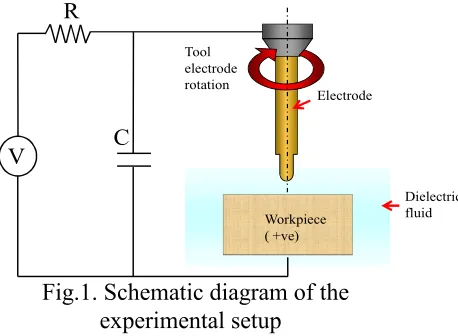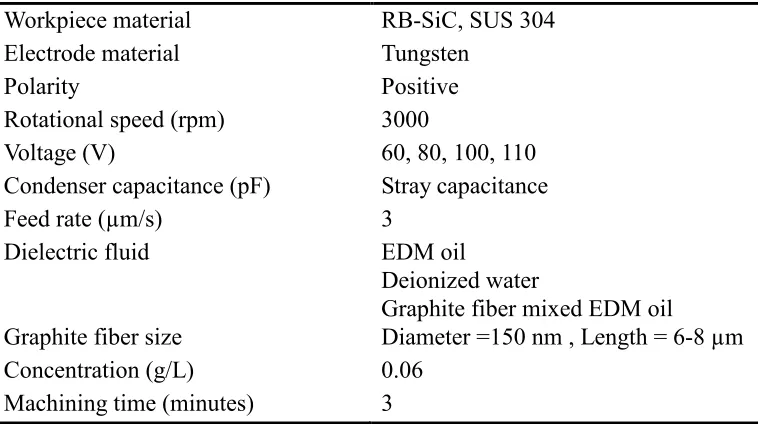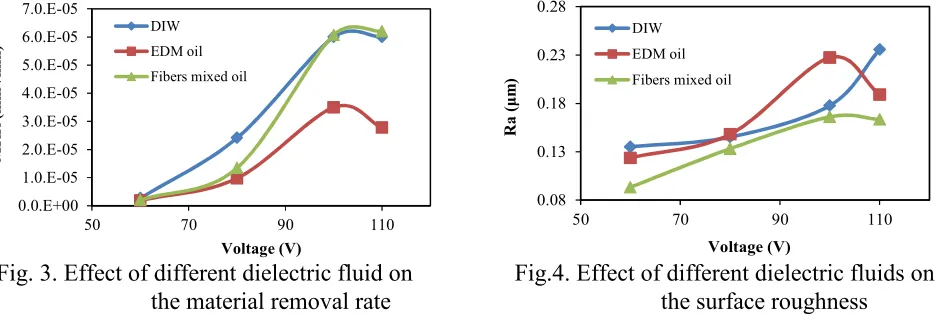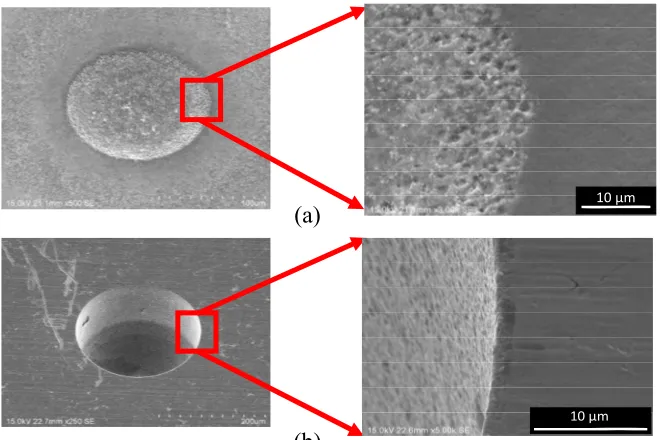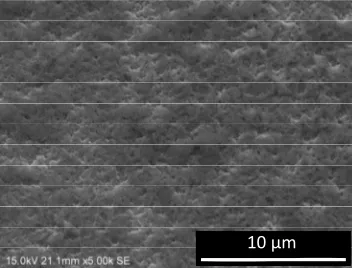Effect of Different Dielectric Fluids on Micro EDM of Low Conductivity
Ceramic Material RB-SiC
Pay Jun LIEW
1,4,a, Jiwang YAN
2,b, Takeshi MASAKI
3,c,
and Tsunemoto KURIYAGAWA
1,d1
Department of Mechanical Systems and Design, Tohoku University, Aramaki Aoba 6-6-01, Aoba-ku, Sendai 980-8579, Japan
2
Department of Mechanical Engineering, Faculty of Science and Technology, Keio University Hiyoshi 3-14-1, Kohoku-ku, Yokohama 223-8522, Japan
3
Masaki Giken, Otokoyamamatsuzato 14-9-201,Yawatashi, Kyoto 614-8364,Japan
4
Manufacturing Process Department, Faculty of Manufacturing Engineering, Universiti Teknikal Malaysia Melaka,Hang Tuah Jaya, 76100 Durian Tunggal, Melaka, Malaysia
a
[email protected], [email protected],
c
[email protected], [email protected]
Keywords: micro EDM, RB-SiC, graphite fiber, deionized water, EDM oil
Abstract. The machining characteristics of reaction bonded silicon carbide (RB-SiC) in micro electrical discharge machining process were studied by using EDM oil, deionized water, and graphite fiber mixed EDM oil as the dielectric fluids. The process performances were measured in terms of material removal rate, surface roughness and surface topography. The effect of deionized water on SUS 304 also was tried and compared with that on RB-SiC. It was found that when graphite fiber mixed EDM oil was used, higher material removal rate, better surface finish and smoother surface topography were obtained compared to that pure EDM oil and deionized water on RB-SiC. Deionized water could produce better form accuracy, however, electrolytic corrosion occurred and small pits were formed around the machining area of RB-SiC. In contrast, electrolytic corrosion was insignificant for SUS 304.
Introduction
Reaction bonded silicon carbide (RB-SiC) is one of the most promising engineering ceramics materials. It has been widely used in various energy and industrial applications, such as for hot parts and wear-resistant parts, due to its superior environmental resistance, high thermal resistance, high wear resistance, high stiffness, high thermal conductivity, low thermal expansion, and low density [1]. Due to its high hardness, RB-SiC is categorized as difficult-to-cut ceramic materials by traditional abrasive machining methods. Hence, micro electrical discharge machining (micro EDM) has been employed to machine this material.
In micro EDM process, both of the electrode and the workpiece are submerged in a dielectric fluid, and the material is removed by electrical discharges between an electrode and the workpiece [2]. The dielectric fluids play an important role in this process. Different dielectric fluids have different composition and cooling rate [3].
Normally, kerosene is used as the dielectric fluid. However, kerosene will decompose and produce carbon during discharge process and caused lower material removal rate [4]. In order to solve this problem, many researches have been done by utilizing deionized water as the dielectric fluid, and it has been found that deionized water is very good with respect to high removal rate and low electrode wear [4-5]. In addition, deionized water also improves significantly the surface finish of the machined surface [6-7]. Although the influence of various dielectric fluids has been investigated extensively, all the previous works have focused on the high conductivity materials. To date, there is no report on a comparative study of different dielectric fluids on low conductivity RB-SiC by micro EDM process.
Advanced Materials Research Vol. 565 (2012) pp 529-534 Online available since 2012/Sep/28 at www.scientific.net
© (2012) Trans Tech Publications, Switzerland doi:10.4028/www.scientific.net/AMR.565.529
Therefore, the main aim of the present work is to compare the machinability of RB-SiC using different dielectric fluids, such as EDM oil and deionized water, on material removal rate, surface roughness and surface topography. Due to the limited conductivity of RB-SiC, the addition of graphite fibers in EDM oil has also been tried by the present authors (unpublished work) and significant improvement in the material removal rates and surface finish could be achieved. Thus, graphite fibers mixed EDM oil was also compared with pure EDM oil and deionized water in this study.
Experimental Methods
The micro hole machining process was performed using Panasonic MG-ED82W micro electrical discharge machine. This machine has a RC discharge circuit, with the stepping resolution of 0.1 µm. Fig. 1 shows a schematic diagram of the experimental setup. The workpiece material used in the experiments was RB-SiC, which is produced by Japan Fine Ceramics Co., Ltd. Some typical material properties of the sample are shown in Table 1. The tungsten electrode was formed by Wire Electrical Discharge Grinding (WEDG) into spherical shape with 100 µm radius. As a dielectric fluid, the EDM oil and deionized water were used in this study. Recent studies of the present authors (unpublished work) have provided evidence for a significant improvement in the material removal rate and surface finish with the addition of graphite fibers in EDM oil. Thus, 0.06 g/L concentration of graphite fibers mixed EDM oil has been compared with pure EDM oil and deionized water. These fibers are 150 nm in diameter and average 6-8 µm in length, as shown in Fig. 2. For pure EDM oil and graphite fibers mixed EDM oil, the electrode was submerged into the dielectric fluid. However, for the deionized water, in order to obtain high resistivity, the deionized water was purified through the deionization cartridge and poured at the machining point. The conductivity was maintained below 0.1 µS/cm and measured with a resistivity meter. The effect of deionized water on SUS 304 also was tried and compared with RB-SiC. In the micro EDM of RB-SiC, negative electrode polarity was used and each trial was performed for duration of 3 minutes at different voltages. Oscilloscope was used to observe the discharge voltage waveform during machining. Table 2 shows the experimental conditions. After the micro hole machining, the surface roughness was measured with a laser probe profilometer NH-3SP (Mitaka kouki Co.Ltd). The measurement was performed at the corner of the micro hole along the radial direction, and the evaluation length was 100 µm. The surface topography of the micro holes was then examined with a scanning electron microscope (SEM).
Table 1. Properties of workpiece material (RB-SiC)
Table 2. Experimental conditions
Workpiece material RB-SiC, SUS 304 Electrode material Tungsten
Material removal rate (MRR). Material removal rate (mm3/min) was calculated as the volume of material removed from workpiece over the machining time. The laser probe profilometer NH-3SP was used to scan across the machined area, and the volume of material removed was obtained by analysing the three-dimensional surface profile. Fig.3 shows the effect of different dielectric fluids on the material removal rate of RB-SiC. As expected, the material removal rate increases with the increase of the voltage, except for 110 V. This figure also reveals that EDM oil produced the lowest MRR, compared to deionized water and graphite fiber mixed EDM oil. The lowest MRR can be explained from two aspects. One is due to the oxidation occurred during micro EDM when deionized water was being used. In contrast, decomposition of carbon and hydrogen take place when using EDM oil and this carbon might be stuck to the electrode and reduce the discharge energy [3, 8]. The other is that during micro EDM with pure EDM oil, the discharge gap between the electrode and workpiece is extremely small, so that the debris could not be removed easily. In this case, a short circuit takes place between the electrode and the workpiece. When short circuit occurs, the electrode will move in the reverse direction of the feed to maintain a bigger gap [9]. The back feeding action will cause a low MRR. In comparison, when the conductive graphite fibers were added into the dielectric fluid, it caused the highest MRR, especially when a high voltage was used. Due to the limited conductivity of RB-SiC, the graphite fibers additive might help to create a conductive network between the electrode and workpiece, hence, the frequency of discharge increased. Additionally, the insulating strength of dielectric fluid will be reduced and this will result a bigger discharge gap between the tool electrode and the workpiece. In this case, debris will be effectively removed from the gap and short circuit will be prevented. As a result, the MRR will be increased significantly.
Properties Values
Si/SiC volume ratio (% / %) 12/88
Density ρ (g/cm3) 3.12
Young modulus E (GPa) 407
Bending strength RT (MPa) 780
Thermal expansion coefficient (10-6/K) 3.23 Thermal conductivity (W/m·K) 143
Porosity (%) <0.1
Surface roughness. The effect of different dielectric fluids on the surface roughness is depicted in Fig 4. As can be clearly seen from this figure, the surface roughness value is lowest when machining was done with graphite fibers additive compared to pure EDM oil and deionized water. This was due to the suitable amount of graphite fibers will lead to uniform dispersion of discharge energy in all directions and cause a smaller crater size, thus surface finish will be improved. In addition, it was found that a lower voltage caused better surface finish. When the voltage is low, the discharge energy is low as well, and caused a smaller crater per discharge if compared to high voltages.
0.0.E+00
Discharge waveform observation. Discharge voltage waveforms for different dielectric fluids were being observed using the Texio DCS 9515 oscilloscope, as shown in Fig.5. As can be seen from this figure, the discharge voltage waveform for EDM oil and deionized water shows no significant difference. However, for the graphite fiber added EDM oil, multiple discharge effect was created within a single input pulse. This is due to the effect of dispersion of discharge energy, which caused higher MRR and better surface finish. This agrees well with the one obtained by Chow et al [10].
(a) (b) (c)
Fig. 5. Discharge voltage waveforms of (a) EDM oil, (b) Graphite fiber mixed EDM oil, and (c) Deionized water (voltage 60 V, stray capacitance)
Surface topography. Fig.6 presents SEM photographs of the machined micro cavities by using different dielectric fluids. It can be clearly observed from the photographs, the machined surface with graphite fiber additive is smoother compared to the one obtained with pure EDM oil and deionized water. With graphite fiber in the dielectric fluid, the sparking gap was increased; consequently, the debris that will cause secondary discharge can be flushed out from the gap more easily. The adhesion of resolidified debris on the machined surface was reduced, resulting a better surface topography. Nevertheless, when machining was performed using deionized water, better form accuracy of machined micro cavity could be obtained. This might be because of the viscosity of the deionized water is lower and sparking gap is bigger compared to EDM oil, so the debris could be drawn out more easily from the machining gap under the same rotation speed, and avoided the formation of a cone shape protrusion at the centre of the micro cavity, as observed in the machined surface produced by pure EDM oil and graphite fiber mixed EDM oil.
100 μm
100 μm 100 μm
5 μm
5 μm 5 μm (a) (b) (c)
Fig. 6. Comparison of machined surface of RB-SiC in (a) Deionized water, (b) EDM oil, and (c) Graphite fibers mixed EDM oil (voltage 60 V, stray capacitance)
Comparison of RB-SiC with SUS 304 using deionized water. A comparison of different workpiece materials, RB-SiC and SUS 304 was done by using deionized water, as shown in Fig. 7. It was found that on the RB-SiC, electrochemical reaction occurred and caused the partial dissolution around the machining area in the form of small pits, resulting surface damage as shown in Fig.8. This might be caused by electrolysis in deionized water. During electrolysis, an oxidation reaction occurs at the positively charged anode, generating oxygen gas and H+, resulting carbon at the anode (from RB-SiC) is oxidized and corroded the material around the machining surface [11]. Hence, it limits the capability of micro EDM on RB-SiC with deionized water. However, this phenomenon was not found on the SUS 304 machining area due to the high corrosion resistance of stainless steel.
(a)
(b)
Fig.7. Comparison of different workpiece surfaces of (a) RB-SiC and (b) SUS 304 by using deionized water at 80 V and stray capacitance
10 μm
10 μm
10 μm
Fig.8. Small pits caused by electrochemical reaction on RB-SiC
Conclusions
The effects of different dielectric fluids on the material removal rate, surface roughness and surface topography of RB-SiC in micro EDM were investigated experimentally. The comparison of surface topography was also done between SUS 304 and RB-SiC. The following conclusions were obtained: 1. By using the graphite fiber mixed EDM oil, material removal rate was higher at high voltages. Better surface finish and smoother surface topography were obtained compared to that pure EDM oil and deionized water on RB-SiC.
2. Deionized water produced better form accuracy. However, electrolytic corrosion occurred around the machining area of RB-SiC.
3. Electrochemical reaction due to deionized water was insignificant for SUS 304.
References
[1] S. Suyama and Y.Itoh: Development of Applications for High-Strength Reaction-Sintered Silicon Carbide, Vol. 61(6)(2006), p. 72-75
[2] I. Puertas and C. J. Luis: J. Mater.Process.Tech., Vol. 153-154(2004), p. 1033-1038
[3] S. L. Chen, B. H. Yan, and F. Y. Huang: J. Mater.Process.Tech., Vol. 87(1999), p. 107-111 [4] K. Kagaya, Y. Oishi, and K. Yada: Precis Eng, Vol. 12(4)(1990), p. 213-217
[5] D. K. Chung, B. H. Kim, and C. N. Chu: J. Micromech and Microeng, Vol. 17(5)(2007), p. 867-874
[6] S. Campana and S. Miyazawa: Micro EDM and ECM in DI Water
[7] D. K. Chung, H. S. Shin, B. H. Kim, M. S. Park, and C. N. Chu: J. Micromech and Microeng, Vol. 19(4)(2009), p. 045025
[8] G. Kibria, B. R. Sarkar, B. B. Pradhan, and B. Bhattacharyya: Int. J. Adv. Manuf. Tech., Vol. 48(5-8)(2009), p. 557-570
[9] E.Takashi ,T.Takayuki, M. Kimiyuki: Precis Eng, Vol. 32(2008), p.269-277
[10] H.M.Chow, B.H.Yan, F.Y.Huang and J.C.Hung:J.Mater. Process.Tech, Vol.101 (2000), p.95-103
[11] T.Masaki, PhD thesis: Study of the Nanometer Accuracy Micro EDM (2009)
Advances in Abrasive Technology XV 10.4028/www.scientific.net/AMR.565
